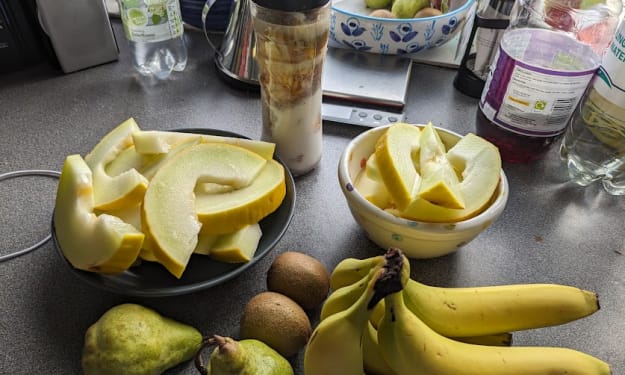How Much of This Equals That? And Other Little Tidbits
Cooking Measurements, Not Rocket Science

Never let a recipe stump you because you cannot figure out unusual calculations such as in these following food items.
Food Calculations
I researched this information several years ago because I needed some information while making a recipe and I did not have an idea at the time.
I listed everything in alphabetical ordered to find the information easier. I keep this list on my refrigerator and have found that I use it more than I ever expected to use it. I hope you will find it as helpful as I did.
- If a recipe calls for 1/3 cup of banana how many bananas do I have to buy for this recipe?
- If a recipe says I need to add 6 1/2 ounces of beans how much should I measure out?
- I need 1 cup of blanched almonds; how many ounces do I have to buy to meet my recipe calculations?
Meat may be another problem because of shrinkage during cooking so if a recipe calls for 2 cups of cubed cooked chicken, how much chicken do I buy at the store?
I made a list of the most used ingredients in recipes and listed a few different calculations for each ingredient. These calculations help me in the kitchen and when grocery shopping.
If you find this information helpful, make a copy of this list and post it in your kitchen.
- Almonds—blanched or slivered, 4-ounce = 1 cup almonds
- Bananas—1 medium = 1/3 cup
- Apples—1 medium = 1 cup sliced
- Beans—1 cup = 6 1/2-ounces; 1-pound
- Bread Crumbs—1 slice fresh bread = 1/2 cup coarse crumbs
- Butter—2 cups = 1 pound or 4 sticks; 1 cup = 1/2 pound or 2 sticks
- Cheese—1 cup shredded = 4 ounces; 1/2 pound = 1 cup grated
- Chicken— large boned chicken breast = 2 cups of cubed cooked meat
- Chicken Broth—13 1/4 ounce can = 1 3/4 cups of broth
- Chocolate—1, 6 ounce package chocolate chips = 1 cup chips or 6, 1 ounce squares
- Cocoa—1, 8 ounce can unsweetened cocoa = 2 cups
- Cream cheese—1, 3 ounce package = 6 Tbsp and 1, 8 ounce package = 1 cup
- Cucumber—1 medium = 1 1/2 cups sliced
- Flour—white or whole wheat, 1 pound = 3 1/2 to 4 cups
- Garlic—2 medium cloves = 1 tsp minced garlic
- Herbs—1 Tbsp fresh herb = 1 tsp dried herbs
- Honey—16 ounces = 1 1/3 cups
- Lemons—1 medium = 1-3 Tbsp juice and 2-3 tsp grated peel
- Marshmallows—1 cup = 16 large, cut up or 160 miniature
- Evaporated Milk—1, 5 ounce can = 2/3; 1, 12 ounce can = 1 2/3 cup; 1, 14 ounce can = 1 1/4 cups
- Mushrooms—1 pound = approximately 6 cups sliced
- Nut meats—4 ounce = 3/4 cup chopped; 1/2 ounce of chopped walnuts = 1 cup
- Onions—1 medium = 1/2 to 3/4 cup chopped; 1 pound = approximately 6 cups sliced
- Oranges—1 medium = 6-8 Tbsp juice and 2-3 Tbsp grated peel
- Shelled Pecans—1 pound = 4 cups halves and 3 1/2 to 4 cups chopped
- Bell peppers—1 large = 1 cup chopped
- Raisins (seedless)—1 pound = 1 1/4 cup to 3 cups
- Brown rice (uncooked)—1 cup = 3 cups to 4 cups cooked
- Long grain rice—1 pound = 2 1/4 cups; 1 cup = 3 cups cooked
- Shortening—1 pound = 2 1/2 cups
- Shrimp—1 pound = 10-15 jumbo; 16-20 large; 25-30 medium
- Sour Cream—1 8-ounce container = 1 cup
- Brown sugar (packed)—1 pound = 2 1/4 cups
- Granulated sugar—1 pound = 2 1/4 cups
- Powdered sugar (confectioners or 4x sugar)—1 pound = 3 1/4 to 4 cups
- Tomatoes—1 pound or 3 medium = 1 1/2 cups peeled and seeded
Smart Cooking

Discover how to cook without losing valuable nutrients.
Fresh produce, meats, and fish are best for quality and price.
Remember when cooking or baking to try to use the freshest of ingredients and monitor expiration dates on containers.
Fresh or frozen vegetables and fruits are best versus the canned variety.
Steam, broil, grill, and bake are the smart way to cook foods. Avoid frying and boiling.
Fresh Herbs

Fresh herbs are better than canned.
Keep small pots of frequently used herbs on your kitchen counter such as dill, basil, thyme, and rosemary.
Meats, Chicken, Fish
Fresh meat selections from a meat market are better than those in the grocery store, and butcher meats are less expensive because you are buying from bulk, versus prepackaged varieties of meat.
Most butcher shops wrap and cut your meats any way you desire. Such as when ordering five pounds of ground chuck, maybe you would like one pound packages, wrapped in freezer paper and labeled. Remember that the freshest food items you buy are the best for price and quality.
About the Creator
Carolann Sherwood
Professional nurse for over 40 years
Owned a children's daycare, eight years
Owned an upper scale clothing resale shop
A freelance writer
Editor since 2010 on a writing platform site
A published author, "Return To The Past" available on Amazon






Comments
There are no comments for this story
Be the first to respond and start the conversation.